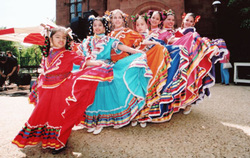
Los Quetzales Mexican Dance Ensemble.
Imagine you finally saved up for that big trip you've been dying to go on. You've made all the travel and hotel arrangements, and have even planned out what sights you are going to visit. After a grueling flight, you land at your destination. After all this time you finally made it! On the drive to the hotel, you have an odd feeling of comfort that normally is designated to being surrounded by familiar things. You brush it off and check into your room. Later that night, you leave the hotel to check out your new surroundings. When you show up to the city center, it looks like any block you'd find in your home town. The food and entertainment are not unique, and the people act and dress just like you. Would it still be worth your time and money?
This is an example of acculturation. It is a plague that is infecting and transforming the world into uniformity and solidarity, and it is up to us to prevent this disease from spreading. As travelers we need to be educated, appreciative, and open to all cultures of areas we intend to travel. Only through this can we hope to preserve different cultures, thus giving us a reason to travel in the first place.
Part of sustaining culture comes from education. It is up to us to study the customs and taboos of the cultures we intend to visit. This keeps these differences the "norm" in the visited destination, and helps natives not feel like the odd one out in their own land. Another way we can help sustain our differences is by supporting establishments that focus on celebrating culture. By supporting these companies and sites we ensure that our tourist dollars go to the local economy, which in turn keeps these cultural celebrations continuing. Examples of these include: art galleries, museums, festivals, fairs, and historic sites. My final bit of advice to the savvy traveler is to be open. Part of the joy of traveling is putting yourself out there and trying new things. By doing this it turns foreign cultures from a spectacle into an experience, which is the only way to fully understand a differing life style.
The good news is that it is not all doom and gloom. Recent statistics show that cultural tourism is on the rise. In 2002 it was estimated that 216.8 million people in the United States were participating in cultural tourism, which is up 13% from 1996. Another encouraging statistic is that 56% of Adult Americans say they include some form of historic, artistic, or humanitarian activity on their vacations. This shows that awareness is rising, and that the people are realizing that westernizing isn't as great as was once thought.
This is a call to arms against the acculturation of the world. This isn't a problem that will work itself our or be corrected by local and foreign governments. It is a change that can only happen on the most basic level, with each of us. By being a sustainable tourist we can ensure that we have a reason to leave our hometown in the future, and keep it that way for generations to come.
(Statistics were pulled from http://www.nasaa-arts.org/Research/Key-Topics/Creative-Economic-Development/Cultural-Visitor-Profile.php. For more statistics like these click here.)
This is an example of acculturation. It is a plague that is infecting and transforming the world into uniformity and solidarity, and it is up to us to prevent this disease from spreading. As travelers we need to be educated, appreciative, and open to all cultures of areas we intend to travel. Only through this can we hope to preserve different cultures, thus giving us a reason to travel in the first place.
Part of sustaining culture comes from education. It is up to us to study the customs and taboos of the cultures we intend to visit. This keeps these differences the "norm" in the visited destination, and helps natives not feel like the odd one out in their own land. Another way we can help sustain our differences is by supporting establishments that focus on celebrating culture. By supporting these companies and sites we ensure that our tourist dollars go to the local economy, which in turn keeps these cultural celebrations continuing. Examples of these include: art galleries, museums, festivals, fairs, and historic sites. My final bit of advice to the savvy traveler is to be open. Part of the joy of traveling is putting yourself out there and trying new things. By doing this it turns foreign cultures from a spectacle into an experience, which is the only way to fully understand a differing life style.
The good news is that it is not all doom and gloom. Recent statistics show that cultural tourism is on the rise. In 2002 it was estimated that 216.8 million people in the United States were participating in cultural tourism, which is up 13% from 1996. Another encouraging statistic is that 56% of Adult Americans say they include some form of historic, artistic, or humanitarian activity on their vacations. This shows that awareness is rising, and that the people are realizing that westernizing isn't as great as was once thought.
This is a call to arms against the acculturation of the world. This isn't a problem that will work itself our or be corrected by local and foreign governments. It is a change that can only happen on the most basic level, with each of us. By being a sustainable tourist we can ensure that we have a reason to leave our hometown in the future, and keep it that way for generations to come.
(Statistics were pulled from http://www.nasaa-arts.org/Research/Key-Topics/Creative-Economic-Development/Cultural-Visitor-Profile.php. For more statistics like these click here.)
 RSS Feed
RSS Feed